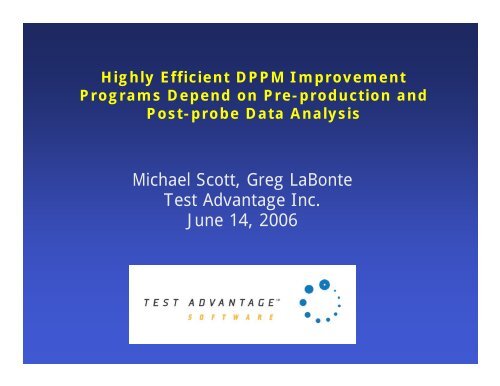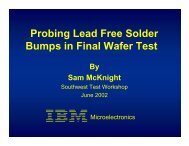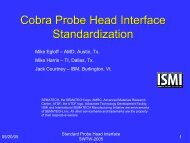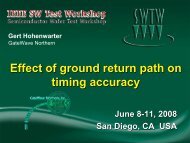Michael Scott, Greg LaBonte Test Advantage Inc. June 14, 2006
Michael Scott, Greg LaBonte Test Advantage Inc. June 14, 2006
Michael Scott, Greg LaBonte Test Advantage Inc. June 14, 2006
Create successful ePaper yourself
Turn your PDF publications into a flip-book with our unique Google optimized e-Paper software.
Highly Efficient DPPM Improvement<br />
Programs Depend on Pre-production and<br />
Post-probe Data Analysis<br />
<strong>Michael</strong> <strong>Scott</strong>, <strong>Greg</strong> <strong>LaBonte</strong><br />
<strong>Test</strong> <strong>Advantage</strong> <strong>Inc</strong>.<br />
<strong>June</strong> <strong>14</strong>, <strong>2006</strong>
Toward Zero Defects<br />
• There is an established relationship between Burn-<br />
In failures/ELFs and abnormal devices in the “Bin 1”<br />
population<br />
• Quality is inversely proportional to “variance”<br />
• Eliminating classified outlier devices from the Bin 1 population<br />
will reduce the number of early life failures<br />
But……………<br />
The <strong>Test</strong>ing environment itself can be a source<br />
of “RISK” to measuring actual device<br />
“variance”<br />
06/<strong>14</strong>/06 <strong>Michael</strong> <strong>Scott</strong> @ SWTW <strong>2006</strong><br />
2
Agenda/Overview<br />
The Keys to Enabling Accurate, Comprehensive,<br />
and Efficient DPPM Reduction<br />
• Parametric and spatial outlier detection<br />
• Quality of measured data<br />
• Pre-production test program development<br />
• Leverage of “hidden” information contained within<br />
the test data<br />
• Post-probe outlier detection optimization<br />
• Summary<br />
06/<strong>14</strong>/06 <strong>Michael</strong> <strong>Scott</strong> @ SWTW <strong>2006</strong><br />
3
Parametric Outlier<br />
• <strong>Test</strong> failures – gross<br />
outlier removal<br />
• Parametric Outliers<br />
– atypical results in<br />
Bin 1 population<br />
06/<strong>14</strong>/06 <strong>Michael</strong> <strong>Scott</strong> @ SWTW <strong>2006</strong><br />
4
Parametric Outlier Classifications<br />
06/<strong>14</strong>/06 <strong>Michael</strong> <strong>Scott</strong> @ SWTW <strong>2006</strong><br />
= <strong>Test</strong> Limit Failure / Outlier<br />
= Bin 1 Outlier<br />
5
Device Classification<br />
Rules Managed via Recipe<br />
• Outlier Device Classification using Magnitude and Frequency<br />
• Specific <strong>Test</strong>s may be considered uniquely<br />
Example Classification Rule:<br />
• Critical Device Outlier = L > 0 or M > 2 or S > 3 = Bin 25<br />
A device may exhibit a smaller magnitude of<br />
variance but have this occurrence across<br />
multiple tests confirming a quality risk device<br />
06/<strong>14</strong>/06 <strong>Michael</strong> <strong>Scott</strong> @ SWTW <strong>2006</strong><br />
6
Spatial Outliers<br />
Proximity<br />
weighting<br />
with<br />
smoothing<br />
Guardbanding<br />
with smoothing<br />
Parametric<br />
Outlier Devices<br />
comprehended<br />
in Spatial<br />
Analysis<br />
Good Die in a Bad<br />
Neighborhood<br />
06/<strong>14</strong>/06 <strong>Michael</strong> <strong>Scott</strong> @ SWTW <strong>2006</strong><br />
7
Highly Efficient DPPM Improvement<br />
Programs Depend on Pre-production and<br />
Post-probe Data Analysis<br />
<strong>Test</strong> Data Quality is a Key<br />
Requirement !<br />
06/<strong>14</strong>/06 <strong>Michael</strong> <strong>Scott</strong> @ SWTW <strong>2006</strong><br />
8
Data analysis automation<br />
Speeds time to market, focusing<br />
Engineering talent on Problem resolution<br />
versus manually grinding through data<br />
STANDARDIZED<br />
Repeatable, automated,<br />
and objective analysis<br />
Recommendations Report<br />
Corrective Actions<br />
<strong>Test</strong> Removal Candidates<br />
<strong>Test</strong> Sampling Candidates<br />
INPUT<br />
Express<br />
OUTPUT<br />
Recommendations Verification Tools<br />
Non-intrusive, ATE independent<br />
– uses industry standard<br />
datalog format<br />
INPUT<br />
Recipe driven approach<br />
produces an automated<br />
analysis, standardizing<br />
test program<br />
qualification<br />
User definable, leveraging existing data analysis libraries<br />
06/<strong>14</strong>/06 <strong>Michael</strong> <strong>Scott</strong> @ SWTW <strong>2006</strong><br />
9
Determination of Poor <strong>Test</strong> Data “Quality”<br />
• Automatically determine key elements contributing to<br />
Poor Quality Data<br />
– Multimodal distributions due to multisite variation<br />
– Clamping or poor resolution due to incorrect<br />
force/measurement ranges<br />
– <strong>Test</strong>er alarms due to incorrect configuration<br />
– Invalid test limits can allow bad devices to pollute<br />
the good device statistics<br />
–Etc<br />
• Provide explicit feedback of Corrective Actions<br />
06/<strong>14</strong>/06 <strong>Michael</strong> <strong>Scott</strong> @ SWTW <strong>2006</strong><br />
10
Multisite Variation<br />
A measurement offset between two test sites has resulted in the detection of<br />
multisite variation, which requires engineering analysis into a possible hardware,<br />
software or calibration issue.<br />
06/<strong>14</strong>/06 <strong>Michael</strong> <strong>Scott</strong> @ SWTW <strong>2006</strong><br />
11
Poor Measurement Resolution<br />
A low number of unique values, which result in a discontinuous (categorical)<br />
distribution histogram, may be as a result of a measurement resolution problem.<br />
06/<strong>14</strong>/06 <strong>Michael</strong> <strong>Scott</strong> @ SWTW <strong>2006</strong><br />
12
Tiered Analysis Strategy<br />
STDF1<br />
Single-STDF<br />
Recipe1<br />
Single-STDF<br />
Results1<br />
Use per-test recommendation summary<br />
&<br />
Per-test historical statistics<br />
SINGLE overall recommendation for each test<br />
STDF2<br />
Single-STDF<br />
Recipe1<br />
Single-STDF<br />
Results2<br />
Historical<br />
Engine<br />
Multi-STDF<br />
Analysis<br />
Reports<br />
Multi-STDF<br />
Recipe1<br />
STDFn<br />
Single-STDF<br />
Recipe1<br />
Single-STDF<br />
Resultsn<br />
‣ Overall Summary – breakdown of recommendations<br />
‣ Summary per test – recommendations, statistics<br />
‣ Drill-down to individual STDF results<br />
‣ Single-click access to interactive charts<br />
06/<strong>14</strong>/06 <strong>Michael</strong> <strong>Scott</strong> @ SWTW <strong>2006</strong><br />
13
Yield/DPPM Recipes<br />
06/<strong>14</strong>/06 <strong>Michael</strong> <strong>Scott</strong> @ SWTW <strong>2006</strong><br />
<strong>14</strong>
Yield/DPPM Recipes<br />
06/<strong>14</strong>/06 <strong>Michael</strong> <strong>Scott</strong> @ SWTW <strong>2006</strong><br />
15
Highly Efficient DPPM Improvement<br />
Programs Depend on Pre-production and<br />
Post-probe Data Analysis<br />
Hidden Data Opportunities for<br />
Improved Outlier Detection<br />
Coverage !<br />
06/<strong>14</strong>/06 <strong>Michael</strong> <strong>Scott</strong> @ SWTW <strong>2006</strong><br />
16
Improving Outlier Detection Coverage<br />
• <strong>Test</strong>s with high outlier density<br />
• Categorical low measurement resolution tests<br />
• Correlated tests that have a directly relatable<br />
performance attribute may be considered for<br />
Regression Outlier analysis<br />
• Corrective actions must be implemented for<br />
engineer-specified Crucial Parametric tests<br />
06/<strong>14</strong>/06 <strong>Michael</strong> <strong>Scott</strong> @ SWTW <strong>2006</strong><br />
17
Identify <strong>Test</strong>s with High Outlier Density<br />
06/<strong>14</strong>/06 <strong>Michael</strong> <strong>Scott</strong> @ SWTW <strong>2006</strong><br />
18
Regression Outliers<br />
• Can utilize high correlation factors to identify inter-dependent tests<br />
• Outlier devices do not conform to the underlying relationship, but may still be<br />
within main distribution for both tests<br />
• Computationally intensive – need to identify candidate tests up front<br />
06/<strong>14</strong>/06 <strong>Michael</strong> <strong>Scott</strong> @ SWTW <strong>2006</strong><br />
19
Regression Outliers<br />
06/<strong>14</strong>/06 <strong>Michael</strong> <strong>Scott</strong> @ SWTW <strong>2006</strong><br />
20
Recommendations<br />
06/<strong>14</strong>/06 <strong>Michael</strong> <strong>Scott</strong> @ SWTW <strong>2006</strong><br />
21
Highly Efficient DPPM Improvement<br />
Programs Depend on Pre-production and<br />
Post-probe Data Analysis<br />
Outlier Detection is a Key<br />
Component of Robust Electronic<br />
Devices Processing<br />
06/<strong>14</strong>/06 <strong>Michael</strong> <strong>Scott</strong> @ SWTW <strong>2006</strong><br />
22
Elements for Comprehensive<br />
Outlier Detection<br />
• Automatic processing of ALL data distribution types<br />
• Automatic application of outlier detection algorithms<br />
on a per wafer per test basis<br />
• Operates on ALL parametric tests automatically<br />
• Comprehension of <strong>Test</strong> Limits and asymmetrical<br />
data distributions in determining control limit<br />
locations<br />
• Advanced Spatial Outlier Detection<br />
• Ease of setup with revision controlled Recipes<br />
06/<strong>14</strong>/06 <strong>Michael</strong> <strong>Scott</strong> @ SWTW <strong>2006</strong><br />
23
Geographic Analysis Requirements<br />
Comprehend test fail bins and parametric analysis bin results<br />
per Electrical Wafer Sort Flow<br />
Flexible recipe defined Spatial Analysis<br />
• Detection of repeating patterns<br />
• Good die in Bad neighborhood<br />
• Cluster Detection<br />
Proximity Analysis Based on a Specified Bin number or numbers<br />
• Wafer edge weighting<br />
• Corner weighting<br />
• Guard banding<br />
• Smoothing<br />
Composite Lot Analysis<br />
• Superimpose lot level wafer maps and perform analysis per X/Y coordinate<br />
based on user defined defect density.<br />
06/<strong>14</strong>/06 <strong>Michael</strong> <strong>Scott</strong> @ SWTW <strong>2006</strong><br />
24
Multi-Flow Analysis & Support<br />
Wafer Fab<br />
Electrical Wafer Sort<br />
Inspection<br />
Class<br />
Probe<br />
EWS1<br />
Any type of<br />
“stress”<br />
EWS2<br />
FOI<br />
Defectivity map 1 Wafer map 2 Wafer map 3 Wafer map 4<br />
Flow 1<br />
stdf1<br />
stdf2<br />
Final<br />
Merged Output<br />
Wafer Map<br />
Streetwise Merge Engine<br />
Recipe Defined Merge Logic<br />
06/<strong>14</strong>/06 <strong>Michael</strong> <strong>Scott</strong> @ SWTW <strong>2006</strong><br />
25
Highly Efficient DPPM Improvement<br />
Programs Depend on Pre-production and<br />
Post-probe Data Analysis<br />
Summary and Results<br />
Key Elements for Success<br />
06/<strong>14</strong>/06 <strong>Michael</strong> <strong>Scott</strong> @ SWTW <strong>2006</strong><br />
26
Closed-Loop Framework<br />
Streetwise & Express Processes<br />
STDF<br />
INPUT<br />
Express<br />
Streetwise<br />
Engineering<br />
Streetwise<br />
Production<br />
DPPM Reduction<br />
Yield Improvement<br />
Optimized<br />
<strong>Test</strong> Program<br />
Development<br />
Detection<br />
Recipe<br />
Development<br />
Advanced<br />
Outlier Detection<br />
Maximize Yield & Minimize DPPM<br />
while shortening Time to Market<br />
Express<br />
<strong>Test</strong> Coverage Optimization<br />
Continuous productivity improvement from<br />
initial production release through product<br />
maturity phases<br />
06/<strong>14</strong>/06 <strong>Michael</strong> <strong>Scott</strong> @ SWTW <strong>2006</strong><br />
27
Accurate Post-Probe Outlier Detection<br />
Average yield Loss Per Wafer<br />
93.00%<br />
91.00%<br />
89.00%<br />
87.00%<br />
% Yield<br />
85.00%<br />
83.00%<br />
Orig Yield<br />
New Yield<br />
81.00%<br />
79.00%<br />
77.00%<br />
75.00%<br />
1 3 5 7 9 11 13 15 17 19 21 23<br />
Wafer Id<br />
Highly Efficient DPPM Reduction<br />
with Minimum Yield Loss<br />
Average Yield Loss - 0.35%<br />
Minimum Typical yield<br />
yield<br />
impact -0.35%<br />
06/<strong>14</strong>/06 <strong>Michael</strong> <strong>Scott</strong> @ SWTW <strong>2006</strong><br />
28
Toward Zero Defect Production<br />
• Automated Data Analysis for Optimized <strong>Test</strong> program<br />
Development<br />
– Reduced Time to Market<br />
– Maximum <strong>Test</strong> Data Quality<br />
– Enhanced Outlier Detection Coverage<br />
– Continuous Production Efficiency Improvement<br />
• Accurate and Efficient Outlier Detection Methodology<br />
– Adaptive Per Wafer Per <strong>Test</strong> Analysis<br />
– Parametric Outlier Device Classification<br />
– Advanced Flexible Geographic Analysis<br />
– Complete, Fully Integrated Automatic Production Solution<br />
Automated Closed Loop Process Optimization<br />
06/<strong>14</strong>/06 <strong>Michael</strong> <strong>Scott</strong> @ SWTW <strong>2006</strong><br />
29









